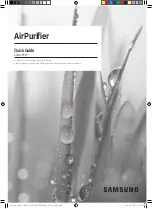
66433-YIM-B-1004
16
Unitary Products Group
CIRCULATING FAN
When the thermostat calls for FAN, the thermostat terminal G
is energized signaling the circulating fan to run at the heat
speed 2 seconds after the G terminal is energized.
If a call for HEAT occurs, the circulating fan continues to run
at the heat speed.
If a call for COOL occurs, the circulating fan switches to cool
speed after a 4 second delay.
When the thermostat ends the call for FAN, the thermostat
terminal G is de-energized, de-energizing the circulating fan.
START-UP
PRE-START CHECK LIST
Complete the following checks before starting the unit.
1.
Check the type of gas being supplied. Be sure that it is
the same as listed on the unit nameplate.
2.
Make sure that the vent outlet air hood has been prop-
erly installed.
OPERATING INSTRUCTIONS
1.
STOP! Read the information on the unit safety label.
2.
Set the thermostat to the OFF position.
3.
Turn off all electrical power to the unit.
4.
DO NOT try to light the burners by hand. This appliance
is equipped with an ignition device which automatically
lights the burners.
5.
Remove the access panel.
6.
Turn the gas valve switch to the OFF position.
7.
Wait five (5) minutes to clear out any gas. If you then
smell gas, STOP! Follow B in the information on the unit
safety label. If you don't smell gas, go to the next step.
8.
Turn the gas valve switch to the ON position.
9.
Replace the control access panel.
10. Turn on all electric power to the unit.
11. Set the thermostat to the desired setting.
12. If the unit will not operate, follow the instructions To Turn
Off Gas To Appliance and call your service technician or
gas supplier.
TO TURN OFF GAS TO UNIT
1.
Set the thermostat to the OFF position.
2.
Turn off all electric power to the appliance if service is to
be performed.
3.
Remove the control access panel.
4.
Turn the gas valve switch to the OFF position. DO NOT
FORCE.
5.
Replace the control access panel.
POST-START CHECK LIST (GAS)
After the entire control circuit has been energized and the
heating section is operating, make the following checks:
1.
Check for gas leaks in the unit piping as well as the sup-
ply piping.
2.
Check for correct manifold gas pressures. See Checking
Gas Input.
3.
Check the supply gas pressure. It must be within the lim-
its shown on rating nameplate. Supply pressure should
be checked with all gas appliances in the building at full
fire. At no time should the standby gas line pressure
exceed 10.5", nor the operating pressure drop below
4.5" for natural gas units. If gas pressure is outside these
limits, contact the local gas utility for corrective action.
MANIFOLD GAS PRESSURE ADJUSTMENT
Small adjustments to the gas flow may be made by turning
the pressure regulator adjusting screw on the automatic gas
valve. Refer to Figure 10.
The ability to properly perform maintenance on
this equipment requires certain expertise, mechan-
ical skills, tools and equipment. If you do not pos-
sess these, do not attempt to perform any
maintenance other than those procedures recom-
mended in this Installation Manual. Failure to heed
this warning could result in serious injury and pos-
sible damage to this equipment.
Summary of Contents for DNZ 060
Page 20: ...66433 YIM B 1004 20 Unitary Products Group FIGURE 13 TYPICAL WIRING DIAGRAM DNZ 208 230 1 60...
Page 21: ...66433 YIM B 1004 Unitary Products Group 21 FIGURE 14 TYPICAL WIRING DIAGRAM DNZ 208 230 3 60...
Page 22: ...66433 YIM B 1004 22 Unitary Products Group FIGURE 15 TYPICAL WIRING DIAGRAM DNZ 460 3 60...









































